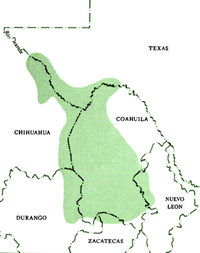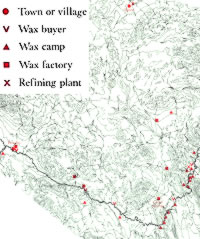
Primary concentration of candelilla
plants and wax production in west Texas and northern
Mexico at the time of surveys by Texas Historical Commission
(THC) archeologists. Click to enlarge.
|

A plume of smoke rises over the river
bank, alerting surveyors to the presence of a small
wax camp. Photo by Curtis Tunnell. Click to enlarge.
|

Burros bolt away from a wax maker
in a riverside camp piled high with cut candelilla.
Photo by Raymond Skiles. Click to enlarge.
|
|
The Chihuahuan Desert reaches its northern limit
in southern New Mexico, includes all of trans-Pecos Texas
except the Guadalupe Mountains, and extends southward through
the states of Chihuahua and Coahuila in Mexico. This vast
area is not noted for its economic productivity. Of course,
most areas serve very well for ranching, with sheep and goats
being more widely accommodated than cattle and horses. Small
amounts of silver, mercury, fluorspar, coal, sand, gravel,
and petroleum have been laboriously extracted in some sections.
Minor products include furs, honey, ornamental cactus, rope
fiber, rubber from guayule, hunting leases for deer and antelope,
tourism, and a modest amount of garden produce, corn, and
cotton from irrigated plots along the rivers.
Perhaps the most interesting and one of the
most economically profitable activities has been the extraction
of wax from the candelilla plant. Since the first decade of
this century, many millions of pounds of this high quality
wax have been removed from wild plants and marketed in dozens
of common products. Much of the wax production has been in
Mexico, but, over the years, varying quantities have been
refined and marketed along the international boundary in Texas.
Many people have subsisted along the Rio Grande by making
wax, and a few have grown rich through marketing.
The camps of the candelilla wax makers are one
of the most common types of cultural sites along the Rio Grande.
During an initial archeological reconnaissance through the
canyons in 1964 as part of a thousand-mile survey of the river
known as the "Cactus Cruise," we began to find and
record abandoned wax camps. Mounds of waste candelilla cascading
over the edge of a silt terrace often indicated site locations,
and these were recorded by means of sketches, notes, and photographs.
Along the river there were many stories about
burro trains of wax smuggled across and sold to representatives
of the big floor-wax companies. One day in the depths of a
canyon, a column of smoke led us to a wax camp in full operation,
and the fascinating story of a fugitive industry began to
be revealed. In intervening years numerous camps from different
decades have been recorded and many good people have consented
to interviews. The stories of candelilla wax and evidence
remaining in the camps have become a permanent part of the
heritage of the Chihuahuan Desert.
The wax camps are an interesting cultural phenomenon
for many reasons and one that might be studied from varying
points of view. The economic botanist, for example, might
view the wax camps as a specialized industry based on exploitation
of a single desert plant species. Historians see the wax industry
as a significant element in the opening of the last frontier.
The anthropologist and sociologist would find material for
study in the transient nature of the camps and the fact that
they are occupied by males only*, who live under primitive
conditions. The folklorist who is fluent in both Spanish and
English would no doubt find the camps a goldmine of information,
ranging from cures and costumes to tales of bandits and heroes
along the river.
For the archeologist, the wax camps are doubly
interesting, being an excellent source of cultural data and
insights in their own right and serving also as a veritable
experimental laboratory for generating and testing hypotheses
relating to prehistoric sites in the region, and the whole
is enhanced by the fact that active camps can be compared
to those that have been abandoned for various periods of time.
For all those who are concerned with the documentation
and preservation of cultural resources, all aspects of the
wax camps and those who live and work in them are significant.
The era of the candelilla camps may one day come to a close,
and it is important that this fascinating facet of our culture
be documented and studied in detail. We can learn valuable
cultural and environmental lessons by studying the camps.
Perhaps most important of all, from the cereros—the
wax makers—we can learn about hard work, productivity,
adaptation, ingenuity, persistence, pride, endurance, determination,
and survival against great odds.
*{Editor's Note: In the section entitled,
"The Industry Today,"
researcher and historian JoAnn Pospisil brings new information
to bear on what has long been considered a "male only"
industry.}
|

Looming canyon walls cast a shadow
over THC surveyors as they maneuver down a stretch of
the Rio Grande. During the archeological reconnaissance
tagged the "Cactus Cruise," surveyors began
to find and record abandoned wax camps. Photo courtesy
Texas Historical Commission. Click to enlarge.
|
|
We can learn valuable cultural and environmental
lessons by studying the camps. Perhaps most important
of all, from the cereros we can learn about hard work,
productivity, adaptation, ingenuity, persistence, pride,
endurance, determination, and survival against great
odds.
|

Locations of wax camp sites, factories,
and buyers at the time of the 1960s survey of the Rio
Grande canyons. Map courtesy of Texas Historical Commission.
Click to enlarge.
|
|





